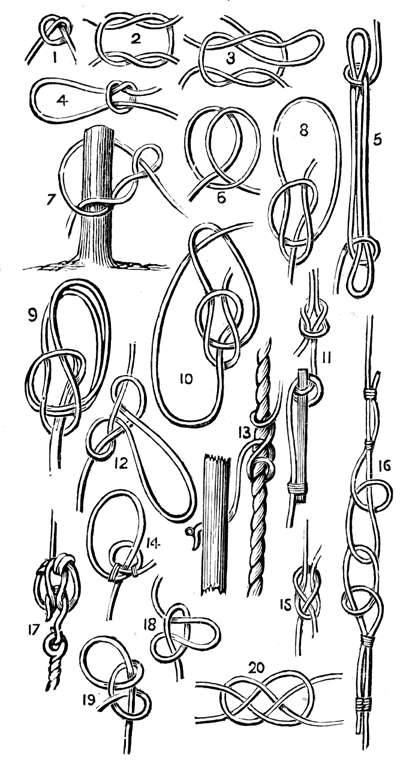
THE TWENTY MOST USEFUL KNOTS.
- Thumb or over-hand knot, tied at the end of a rope to prevent it from opening out, &c.
- Right or reef-knot, for securing all lashings where the ends of the rope meet together.
- Draw-knot, which offers great facility in undoing.
- Running-knot, used to bind or draw anything close.
- Sheepshank, serving to shorten a rope without cutting it or unfastening the ends.
- Clove-hitch, which binds with excessive force, and by which alone a weight can be hung to a smooth pole.
- Timber-hitch, very useful in hauling to move a weight.
- Single bowline-knot, difficult to undo, useful to throw over a post &c., to haul on, used for the draw-loop of a slip noose.
- Double bowline-knot, for slinging a cask.
- Running bowline-knot.
- Woolding or packing-stick hitch, used to tighten ropes.
- Men’s harness hitch, passing over the shoulder and under the opposite arm of men drawing a carriage, &c.
- Stopper hitch, for stoppering the fall of a tackle, &c.
- Inside clinch, for fastening a cable to the anchor ring, &c.
- Common or sheet bend, a very secure method of joining two ropes, or fastening a rope to a loop.
- Hawser bend, for joining two ropes, easily undone.
- Cat’s paw, the turn in the bight of a rope, for hooking a tackle to it.
- Dragrope or lever-hitch, used for fixing hand-spikes or capstanbars to the ropes attached to heavy carriages, &c., which have to be moved by men.
- Half-hitch, cast on the bight of a rope.
- Carrick bend. A wall-knot is a knot made at the end of a rope to prevent it from passing through a hole.
— The Household Cyclopedia of General Information, 1881
